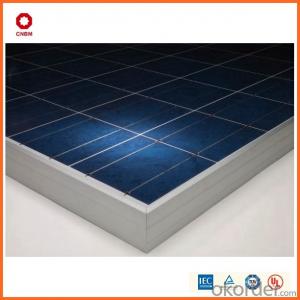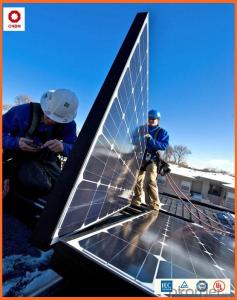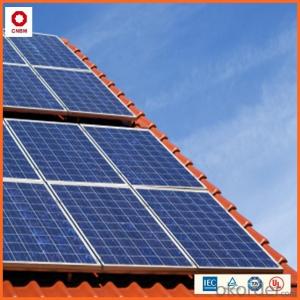65w Small Solar Panels in Stock China Manufacturer
- Loading Port:
- China main port
- Payment Terms:
- TT OR LC
- Min Order Qty:
- 1 watt
- Supply Capability:
- 10000000 watt/month
OKorder Service Pledge
OKorder Financial Service
You Might Also Like
Item specifice
Product Description:
Hot Sale !!! Quality and Safety of Small Poly Solar Panel 5w~150w
1. Rigorous quality control meets the highest international standards.
2. High-transmissivity low-iron tempered glass, strong aluminium frame.
3. Using UV-resistant silicon.
4. IS09001/14001/CE/TUV/UL
Warranties of Small Poly Solar Panel 35~85w
1. 10 years limited product warranty
2. 15 years at 90% of the minimal rated power output
3. 25 years at 80% of the minimal rated power output
Specification
Characteristics of Poly solar panels CNBM (245-320W) | |||||
Max Power Voltage Vmp(V) | 30.3 | 30.8 | 31.1 | 31.4 | 31.85 |
Max Power Current Imp(A) | 7.60 | 7.64 | 7.73 | 7.81 | 7.85 |
Open Circuit Voltage Voc(V) | 36.1 | 36.6 | 37 | 37.3 | 37.68 |
Short Circuit Current Isc(A) | 8.50 | 8.55 | 8.65 | 8.75 | 8.85 |
Max Power Pm(W) | 230W | 235W | 240W | 245W | 250W |
Temperature Coefficient of Cells Poly solar panels CNBM (245-320W) | |
NOCT | 45± 2 |
Temperature Coeffucients of Isc | 0.0492 |
Temperature Coeffucients of Voc | -0.3374 |
Temperature Coeffucients of Voc | -0.4677 |
Mechanical Data of Poly solar panels CNBM (245-320W) | |
Dimension | 1638 × 982 × 40 mm |
Weight | 19.5 kg |
No. of Cells and Connections | 60 (6 ×10) |
Tolerance | 0 ~ + 5 W |
Cell | Monocrystalline Cell 156 × 156 mm |
Packing | 624 Pcs/40ft(H) Container |
Limits of Poly solar panels CNBM (245-320W) | |
Operating Temperature | -40 to +85 |
Storage Temperature | -40 to +85 |
Max System Voltage | 1000VDC(IEC) / 600VDC(UL) |
Features of our products:
• High conversion efficiency mono/poly-crystalline amorphous silicon solar cells
• Modules incorporate high performance bypass diodes to minimize the power drop caused by shading
• High transmittance, low-iron tempered glass
• High performance EVA encapsulant to prevent destroying and water.
• AI frame: without screw, corner connection. 8 holes on the frame can be installed easily
• Good performance of preventing from atrocious weather such as wind and hails
• Certifications: CE IEC TUV VDE UL, Class I
• 10 years 90% power output warranty

Shipping of Small Poly Solar Panel 35~85w
By Sea | Delivery from Shanghai or Ningbo seaport |
By Air | Departure from Shanghai Pudong Airport |
By Express | Post by DHL, EMS, UPS, TNT. |
Features of our products:
• High conversion efficiency mono/poly-crystalline amorphous silicon solar cells
• Modules incorporate high performance bypass diodes to minimize the power drop caused by shading
• High transmittance, low-iron tempered glass
• High performance EVA encapsulant to prevent destroying and water.
• AI frame: without screw, corner connection. 8 holes on the frame can be installed easily
• Good performance of preventing from atrocious weather such as wind and hails
• Certifications: CE IEC TUV VDE UL, Class I
• 10 years 90% power output warranty
As a professional Solar Panel manufacturer and Supplier in China, we have our customers come around the whole world and our specialization has got a worldwide recognition. Meanwhile, with our superior quality, competitive price, prompt and excellent service, As main role in trade section of CNBM Group, CNBM International Corporation supplies products including Monocrystalline Solar Panel, Polycrystalline Solar Panel ( multicrystalline silicon Solar Panel) have received and enjoyed famous reputation in many countries and regions in the world.
- Q:How does the efficiency of solar panels vary across different angles of sunlight?
- The efficiency of solar panels can vary across different angles of sunlight due to several factors. One factor is the incident angle of sunlight. Solar panels are most efficient when sunlight strikes them perpendicular to their surface. As the angle of sunlight becomes more oblique, the energy output of the panels decreases. This is because when sunlight strikes the panel at an angle, it has to travel a longer distance through the material, resulting in more absorption and reflection, and less energy conversion. Another factor is the tracking system of solar panels. Some solar panels have tracking systems that allow them to follow the sun's movement throughout the day, optimizing the angle of incidence. These tracking systems can significantly increase the efficiency of solar panels, as they ensure that the panels are always aligned with the sunlight, maximizing the energy output. Furthermore, the efficiency of solar panels can also be affected by the type of solar cell technology used. Different types of solar cells have varying sensitivities to the incident angle of sunlight. For example, monocrystalline silicon solar cells tend to have higher efficiencies at steeper angles of sunlight compared to polycrystalline or thin-film solar cells. In summary, the efficiency of solar panels can vary across different angles of sunlight due to factors such as incident angle, tracking systems, and the type of solar cell technology used. Optimizing the angle of incidence and implementing tracking systems can help maximize the efficiency of solar panels and increase their energy output.
- Q:Can solar energy systems be used for powering electric vehicle carpooling services?
- Yes, solar energy systems can be used to power electric vehicle carpooling services. Solar energy systems generate electricity by converting sunlight into usable energy, which can be used to charge electric vehicles. By installing solar panels on the carpooling service's parking lot or charging stations, the vehicles can be charged directly from the sun's energy. This not only reduces the carbon footprint of the carpooling service but also helps in promoting renewable energy usage. Additionally, solar-powered carpooling services can benefit from reduced electricity costs as they would rely less on the grid for charging the vehicles.
- Q:Are solar energy systems environmentally friendly?
- Yes, solar energy systems are environmentally friendly. They produce clean and renewable energy by harnessing the power of the sun, which reduces the reliance on fossil fuels. Solar energy systems do not emit greenhouse gases or other harmful pollutants during operation, making them a sustainable and environmentally responsible choice for generating electricity.
- Q:How do solar energy systems contribute to reducing electricity bills?
- Solar energy systems contribute to reducing electricity bills by generating electricity from the sun's energy, which is free and abundant. By harnessing this renewable source of energy, homeowners and businesses can offset their reliance on traditional electricity grids, resulting in lower consumption from utility companies and ultimately reducing their electricity bills. Additionally, excess electricity generated by solar panels during peak sunlight hours can be fed back into the grid, earning credits or payments that further offset the costs of electricity bills.
- Q:What is the impact of snow cover on the performance of solar panels?
- The impact of snow cover on the performance of solar panels can vary depending on the severity and duration of the snowfall, as well as the design and tilt angle of the panels. When solar panels are covered in snow, they are unable to generate electricity as effectively. The snow blocks the sunlight from reaching the panel's surface, reducing the amount of energy that can be converted. This can lead to a decrease in the overall power output of the solar system during the snowy period. However, it is important to note that most solar panels are designed to have a tilt angle that allows for natural snow shedding. When the panels are installed at an angle, the snow can slide off more easily, exposing the surface and allowing sunlight to once again reach the photovoltaic cells. In regions with regular snowfall, it is common for solar panel installations to have a steeper tilt angle to facilitate snow removal. Additionally, some solar panels are equipped with anti-reflective coatings or self-cleaning features that can help reduce the impact of snow cover. These coatings or features can prevent snow from sticking to the surface, allowing for faster snow removal and improved performance. It is worth mentioning that snow cover can also have a positive impact on solar panels in certain cases. A thin layer of snow can act as an insulating layer, helping to retain heat and potentially increase the efficiency of the panels. However, this effect is generally minimal and limited to specific conditions. Overall, while snow cover can temporarily reduce the performance of solar panels, the impact can be mitigated through proper installation techniques and design considerations. In areas with regular snowfall, it is important to consider the tilt angle, anti-reflective coatings, and self-cleaning features to ensure optimal performance throughout the year.
- Q:Can solar energy systems be used for powering remote monitoring equipment?
- Solar energy systems have the capability to power remote monitoring equipment. By utilizing photovoltaic (PV) panels, solar energy systems can convert sunlight into electricity, enabling the operation of various devices and equipment. Solar energy systems are well-suited for powering remote monitoring equipment, such as weather stations, surveillance cameras, or communication systems. These systems are particularly advantageous in isolated or off-grid areas where access to electricity may be scarce or nonexistent. Solar energy, being sustainable and renewable, is an excellent alternative to fossil fuels and traditional electrical grids for providing power to remote monitoring equipment. Moreover, solar energy systems can be combined with battery storage to ensure a continuous power supply, even during periods of limited sunlight.
- Q:Can solar energy systems be used to power boats or yachts?
- Yes, solar energy systems can indeed be used to power boats or yachts. Solar panels can be installed on the roof or deck of a boat to capture sunlight and convert it into electricity. This electricity can then be used to power various onboard systems, such as lights, navigation equipment, communication devices, refrigeration, and even propulsion systems. The size and capacity of the solar energy system will depend on the specific power requirements of the boat or yacht, as well as the available space for installation. Solar-powered boats and yachts offer several advantages, including reduced reliance on fossil fuels, lower operational costs, quieter operation, and reduced carbon emissions. However, it is important to note that solar energy alone may not be sufficient to power larger vessels or during prolonged periods of low sunlight. In such cases, a hybrid system that combines solar energy with other power sources, such as wind or diesel generators, may be more suitable.
- Q:Can solar energy systems be used in areas with limited access to solar panel manufacturers?
- Yes, solar energy systems can still be used in areas with limited access to solar panel manufacturers. In such cases, the focus would be on importing solar panels from manufacturers in other regions or countries. Additionally, efforts can be made to promote local manufacturing or assembly of solar panels to overcome the limitations and ensure the availability of solar energy systems in those areas.
- Q:How do solar energy systems impact property value?
- Solar energy systems can have a positive impact on property value as they are considered a desirable and sustainable feature by potential buyers. Studies have shown that homes with solar panels tend to sell faster and at a higher price compared to homes without them. Additionally, these systems can lead to reduced energy costs for homeowners, further increasing the value of the property.
- Q:Can solar energy systems be installed on flat surfaces?
- Yes, solar energy systems can be installed on flat surfaces. While it is more common to install solar panels on angled surfaces to maximize sunlight absorption, flat surfaces can still be utilized for solar energy systems. Mounting systems can be used to tilt the panels towards the sun and optimize energy production even on flat surfaces.
1. Manufacturer Overview |
|
|---|---|
| Location | |
| Year Established | |
| Annual Output Value | |
| Main Markets | |
| Company Certifications | |
2. Manufacturer Certificates |
|
|---|---|
| a) Certification Name | |
| Range | |
| Reference | |
| Validity Period | |
3. Manufacturer Capability |
|
|---|---|
| a)Trade Capacity | |
| Nearest Port | |
| Export Percentage | |
| No.of Employees in Trade Department | |
| Language Spoken: | |
| b)Factory Information | |
| Factory Size: | |
| No. of Production Lines | |
| Contract Manufacturing | |
| Product Price Range | |
Send your message to us
65w Small Solar Panels in Stock China Manufacturer
- Loading Port:
- China main port
- Payment Terms:
- TT OR LC
- Min Order Qty:
- 1 watt
- Supply Capability:
- 10000000 watt/month
OKorder Service Pledge
OKorder Financial Service
Similar products
New products
Hot products
Hot Searches
Related keywords






























